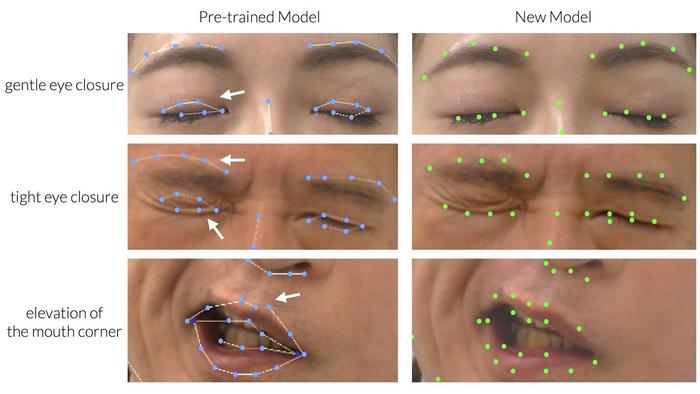
A groundbreaking advancement in artificial intelligence (AI) has emerged as a promising tool for the objective evaluation of patients suffering from facial palsy. This innovative research provides a detailed insight into the potential of AI technology to enhance the accuracy of clinical assessments. The study, conducted by a team led by Dr. Takeichiro Kimura of Kyorin University in Japan, aims to refine automated evaluations of facial palsy using a method termed “fine-tuning,” which involves comprehensive machine learning techniques.
Facial palsy, a condition encompassing paralysis or partial loss of facial movement, presents significant challenges in a clinical setting. These challenges arise from the need for precise evaluations to guide treatment decisions, particularly in cases where nerve transfer surgery might be indicated. Traditional subjective scoring systems to assess facial function suffer from inconsistencies and variability among practitioners. Consequently, there is a pressing need for an objective assessment mechanism that can reliably quantify facial motor function in affected patients.
In previous attempts to utilize AI in facial recognition, models such as 3D-FAN—designed to identify keypoints across the face—had significant limitations. These models, initially developed on datasets of individuals with standard facial movements, often failed to accurately detect asymmetrical features indicative of facial palsy. For instance, in situations where patients were prompted to smile or close their eyes, the system frequently overlooked critical discrepancies in facial symmetry, undermining the reliability of its assessments.
.adsslot_rQYbdzoG72{width:728px !important;height:90px !important;}
@media(max-width:1199px){ .adsslot_rQYbdzoG72{width:468px !important;height:60px !important;}
}
@media(max-width:767px){ .adsslot_rQYbdzoG72{width:320px !important;height:50px !important;}
}
ADVERTISEMENT
Dr. Kimura and his colleagues identified the urgent need to enhance the 3D-FAN model by employing a fine-tuning approach based on a diverse dataset of clinical video images. By utilizing a comprehensive collection of 1,181 images sourced from videos featuring 196 patients diagnosed with facial palsy, the team was able to retrain the model to accurately recognize facial keypoints. This process required manual adjustment of landmark positions to reduce variability, followed by repeated training sessions until no further improvements were noted.
Following the fine-tuning, the AI model exhibited a marked enhancement in its ability to detect facial keypoints. Notably, the error rates in assessing key points showed significant reductions. The improvement was particularly evident in sensitive areas such as the eyelids and mouth, where asymmetry plays a critical role in evaluating the severity of facial palsy. The researchers documented these advancements through clear illustrations, demonstrating the considerable gains made in accurate facial analysis post-machine learning adaptation.
The implications of this refined AI tool are profound, suggesting its application might extend beyond facial palsy to other medical conditions characterized by rare disorders. The fine-tuning method, with its focus on manually correcting facial landmarks within a limited dataset, could pave the way for similar advancements in other specialized applications of AI-assisted diagnostics. The intent is to allow clinicians and researchers to utilize this upgraded model freely, fostering collaboration and innovation in the broader medical community.
As the authors underscore, this software represents a significant step towards establishing reliable methodologies for objective evaluations in clinical settings. Currently, the research team is conducting a multidisciplinary analysis to assess the overall effectiveness of this AI system in practical clinical environments. By integrating AI into routine assessments of facial palsy, it is anticipated that clinicians can achieve a more thorough understanding of patient conditions, thereby leading to improved treatment outcomes.
The fine-tuned AI tool aligns with ongoing efforts within the medical community to adopt technology-driven solutions that enhance patient care. By delivering objective data for the assessment of facial palsy severity, this advancement stands to transform how facial nerve injuries are diagnosed and treated. Ultimately, equipping practitioners with an accurate, data-driven platform may ensure that patients receive the most appropriate and effective interventions.
In summary, the journey towards integrating fine-tuned AI into the clinical evaluation of facial palsy is an exciting development indicative of the future of medical diagnostics. This study highlights the potential to harness machine learning in enhancing clinical assessments, paving the way for further research on AI applications in less common medical disorders. The authors express confidence that widespread adoption of such innovative tools could lead to significant improvements in patient care, enabling a more scientific approach to treatment.
Through this pioneering research, Dr. Kimura and his team have not only contributed to the understanding of facial palsy evaluation but have also demonstrated the broader implications that AI technology can have in various domains of healthcare. The anticipation surrounding the upcoming applications of this refined AI model emphasizes the transformative potential of integrating advanced computational tools within medical practices.
In conclusion, the findings from this study offer a glimpse into the promising future of AI-assisted medical evaluations. Such advancements hold the key to creating more reliable, objective, and ultimately transformative approaches to patient assessment and management in the ever-evolving landscape of healthcare.
Subject of Research: Automated evaluation of facial palsy using AI
Article Title: Fine-Tuning on AI-Driven Video Analysis through Machine Learning: Development of an Automated Evaluation Tool of Facial Palsy
News Publication Date: May 29, 2025
Web References: Plastic and Reconstructive Surgery Journal Article
References: N/A
Image Credits: Plastic and Reconstructive Surgery®
Keywords
Health and medicine, Artificial intelligence, Machine learning, Deep learning
Tags: advancements in facial recognition technologyartificial intelligence in healthcareautomated facial palsy assessmentchallenges in facial palsy treatmentclinical applications of AI in surgeryenhancing accuracy in clinical assessmentsfine-tuning machine learning modelsinnovative AI tools in plastic surgerymachine learning for medical evaluationsnerve transfer surgery evaluationobjective evaluation of facial paralysissubjective scoring systems in medicine





